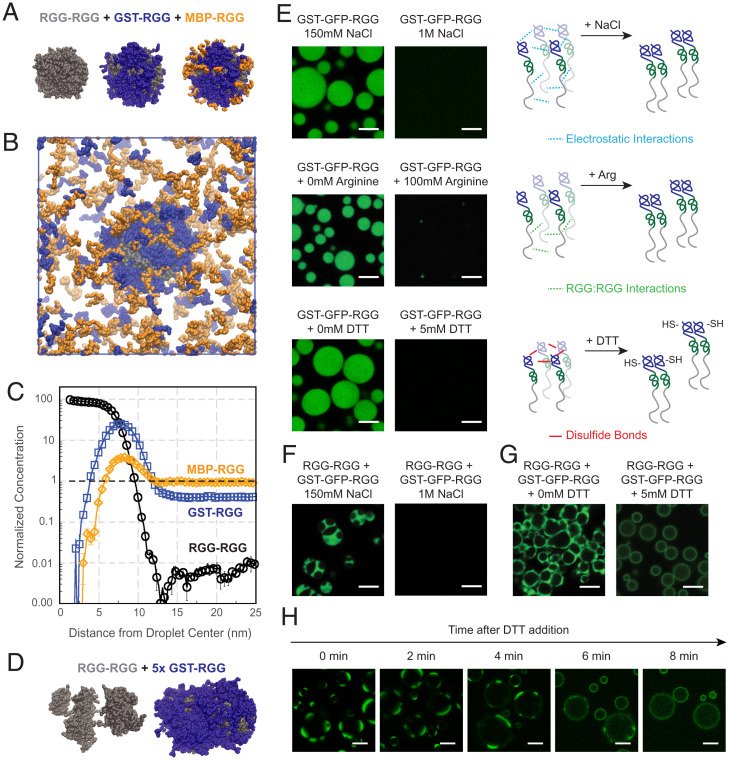Fig. 6.
Simulations identify domain interactions that can be modulated to tune multiphasic assembly. (A) Simulation snapshots of a condensate formed from a ternary mixture with equal concentrations of RGG-RGG (gray), GST-RGG (blue), and MBP-RGG (orange). All images are from the same snapshot, highlighting surface concentrations of different sets of components. GST-RGG displays a higher degree of coverage of the RGG-RGG surface compared to MBP-RGG. (B) Simulation snapshot displaying the condensed and dilute phases from A. Higher concentration of MBP-RGG relative to GST-RGG is observed in the dilute phase. (C) Quantification of protein concentration distribution in space. Protein concentration is normalized to the total concentration of each species in the solution. Mixing MBP-RGG and GST-RGG with RGG-RGG results in greater GST-RGG localization to the surface while MBP-RGG remains in solution. (D) MD simulation of RGG-RGG with 5× GST-RGG concentration. RGG-RGG forms multiple cores (Left) surrounded by a GST-RGG phase (Right). (E) Confocal fluorescence imaging of GST-GFP-RGG (25 µM) at the standard buffer conditions (150 mM NaCl and 20 mM Tris, pH 7.5) versus with 1 M NaCl (Top), 100 mM L-arginine (Middle), and 5 mM DTT (Bottom). Schematics illustrate that high salt hinders phase separation of GST-GFP-RGG through weakening electrostatic interactions. Addition of L-arginine prevents phase separation of GST-GFP-RGG by competing with Arg–Tyr interactions in the RGG domains, thus decreasing RGG–RGG interactions. DTT inhibits phase separation by preventing disulfide bond formation between cysteines in the GST domains. (F) Confocal fluorescence imaging of RGG-RGG (5 µM) and GST-GFP-RGG (10 µM) at 150 mM NaCl versus 1 M NaCl. High salt prevents phase separation of both the RGG-RGG core droplets and the surrounding GST-GFP-RGG phase. (G) Confocal fluorescence imaging of RGG-RGG (5 µM) and GST-GFP-RGG (10 µM) at 150 mM NaCl, without and with addition of 5 mM DTT. Addition of DTT disrupts the disulfide bonds between GST domains, resulting in loss of the GST-GFP-RGG phase and formation instead of GST-GFP-RGG films surrounding RGG-RGG droplets. RGG-RGG is devoid of Cys and is insensitive to DTT. (H) Time-lapse microscopy of RGG-RGG + GST-GFP-RGG after DTT addition shows the hierarchical structures evolving into film-enveloped condensates in the reducing environment. (Scale bars, 5 µm.)

